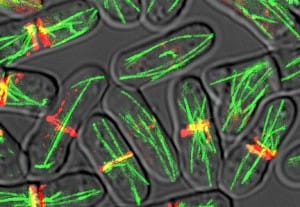

Each plasmid harboring one DNA fragment is received by one cell. A library of plasmids containing fission yeast DNA fragments is transformed into cdc2 ts cells at 25☌, and the cells are then incubated at 35☌. The cloning of the cdc2 + gene is used as an example to illustrate the principle underlining the approach. Adapted based on (Allshire & Karpen, 2008). Broad arrows represent various repetitive elements at centromeres. Centromere lengths, histone size, and histone numbers are not to scale. Colored circles above the centromeric sequences are representative of the enriched histone type associated with the centromeric domain. Overall, the centromeric arrangement in fission yeast, with distinctive repeats and heterochromatinization, is much closer to the organization observed in humans. The centromeric arrangement in human chromosomes spans a larger region, containing multiple repeat units associated with methylated histone variants resulting in a large heterochromatin region at the centromere. The outer repeat regions ( otr) lie on either side of the central domain and are primarily associated with the heterochromatinization of the centromere. pombe centromere, on the other hand, has a central domain consisting of a central core flanked by innermost repeat ( imr) regions. cerevisiae displays a very short centromeric region with no distinct heterochromatinization. CDC28 ts encodes a Cdc2 master protein kinase homolog at the restrictive temperature, this mutant cannot progress into S-phase, exhibiting a non-budding phenotype. The G 1–S transition is the major control point for the cell cycle (arrow). The budding yeast cell cycle features distinct G 1 and S phases the G 2 and M phases are not clearly defined. cdc2 ts encodes a master protein kinase that is involved in cell cycle regulation. Most cell-division cycle ( cdc) mutants are blocked at G 2, and thus are incapable of entering mitosis, displaying a cell elongation phenotype at a restrictive temperature. The G 2–M transition is usually the major control point for the cell cycle (arrow). The daughter nuclei segregate and initiate G 1 however, cytokinesis and the final separation of the new cells do not take place until the S-phase. A cell typically spends the longest time in the G 2 phase (~70-80%). The fission yeast follows the conventional mitotic cycle with distinct, consecutive G 1, S, G 2, and M phases. Schizosaccharomyces pombe fission yeast cell cycle epigenetics genetics micromammal.Ī. We especially focus on the advantages of and the advancements in using fission yeast for studying biological processes that are characteristic of metazoans to decipher the underlining molecular mechanisms fundamental to all eukaryotes. pombe as a unicellular "micromammal" in investigating biological questions. pombe's rise as a valuable model organism and presents examples to highlight the significance of S. Versatile experimental approaches are amenable using the fission yeast system due to its relative ease of maintenance, its inherent cellular properties, its power in classic and molecular genetics, and its feasibility in genomics and proteomics analyses. pombe serves as an excellent system for undergraduate students to obtain hands-on research experience. pombe has become an increasingly used model to investigate various molecular and cellular processes over the last 50 years. With the advent of new methodologies for research, S. pombe shares more common features with humans including gene structures, chromatin dynamics, and the prevalence of introns, as well as the control of gene expression through pre-mRNA splicing, epigenetic gene silencing, and RNAi pathways. As a yeast divergent from the budding yeast Saccharomyces cerevisiae, S. The fission yeast Schizosaccharomyces pombe is a rod-shaped unicellular eukaryote, well known for its contributions as a model organism for our understanding of regulation and conservation of the eukaryotic cell cycle.


 0 kommentar(er)
0 kommentar(er)
